The 2012 MacBook Air (11 & 13-inch) Review
by Anand Lal Shimpi on July 16, 2012 12:53 PM EST- Posted in
- Apple
- Mac
- MacBook Air
- Laptops
- Notebooks
The Display
The MacBook Air is really Apple's mass-market notebook, and as such it's not going to be the target for a Retina Display upgrade, at least not this year. While technically feasible, my guess is a lack of supply kept a rMBA out of the cards for this year. There's also the matter of maintaining its thin profile and battery life in pursuit of a retina display.
The MacBook Air display continues to be good, and better than most, but no where near what the rMBP delivers and actually a step behind what the competition in the PC space has been cooking up.
If there was one clear trend at Computex this year it's towards IPS 1080p displays in Windows 8 notebooks. ASUS actually pre-empted all of the exciting announcements (rMBP included) with its Zenbook Prime, complete with 11 and 13-inch 1080p IPS displays. As the MacBook Air retains its TN display, for the first time we can actually say that ASUS' Ultrabook offers better viewing angles than the Air. The difference is quite noticeable:
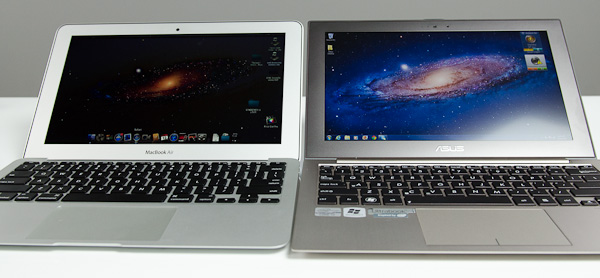
2012 MacBook Air (left) vs. 2012 ASUS Zenbook Prime (right)
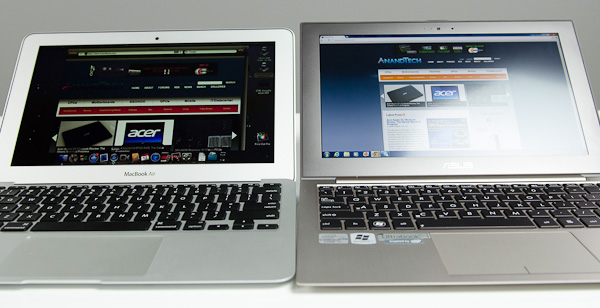
2012 MacBook Air (left) vs. 2012 ASUS Zenbook Prime (right)
ASUS also enjoys a resolution advantage, but it's not really high enough to make good use of integer DPI scaling (at 2x you get a UI sized for a 960 x 540 display). You get sharpness, and additional desktop area, but not the total package you get with the rMBP. There's no denying that what ASUS has done is better, it's just not perfect. And as Apple has shown us in the past, it's not fond of stopgap solutions.
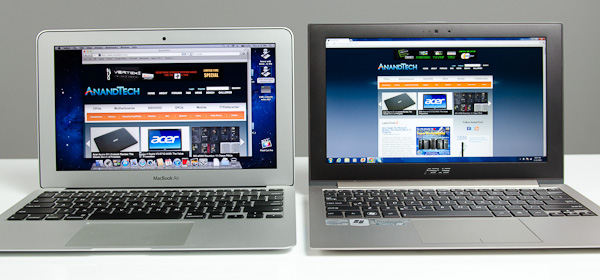
2012 MacBook Air (left) vs. 2012 ASUS Zenbook Prime (right)
Brightness, black levels, contrast, color accuracy and gamut haven't changed over the past year. The MacBook Air's panel remains one of the best non-IPS solutions on the market. The problem is that consumer insistence higher quality displays has pushed Apple's competitors to finally deliver more than TN at MacBook Air price points. Sooner rather than later, Apple will have to respond.
The Panel Lottery
Unlike in previous years, there appears to be three manufacturers supplying panels for the 2012 MacBook Air. LG Philips and Samsung return from before, but AUO now joins the fray. It's quite possible that Apple's volumes have grown large enough to justify adding a third supplier - a trend we may see increase in the future, and across more component categories.
As always, you can try to find out what panel is used in your MacBook Air by executing the following command in an OS X Terminal window:
ioreg -lw0 | grep IODisplayEDID | sed "/[^<]*</s///" | xxd -p -r | strings -6
The output will look something like this:

As long as Apple hasn't masked the data, the first line should be the part number of your display panel. The first one or two characters will tell you the manufacturer: LP for LG Philips, LT for Samsung and B for AUO. Anecdotally, LG and Samsung seem to be the most prevalent. In my personal experience with six 13-inch 2012 MacBook Airs and three 11-inch MacBook Airs, the breakdown was as follows:
13-inch $1499 - Samsung
13-inch $1499 - Samsung
13-inch $1499 - Samsung
13-inch $1499 - Samsung
13-inch $1499 - Samsung
13-inch $2199 - LG
11-inch $1099 - AUO
11-inch $1099 - AUO
11-inch $999 - Samsung
A thread over on Macrumors places the Samsung/LG split much closer to 50/50, however it's not clear if there's a higher incidence of LG panels in BTO or non-default configurations. We'd need many more samples to really get an idea for how all of this shapes up, so don't put too much faith in the results from my experience.
Apple does its best to ensure that all three panels deliver comparable performance, however there are differences. Let's first start with the numbers:
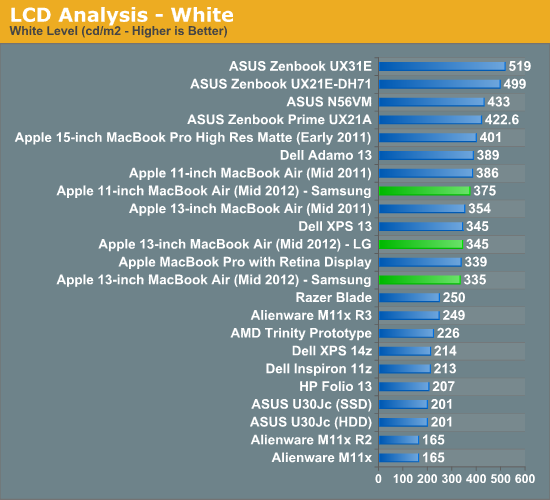
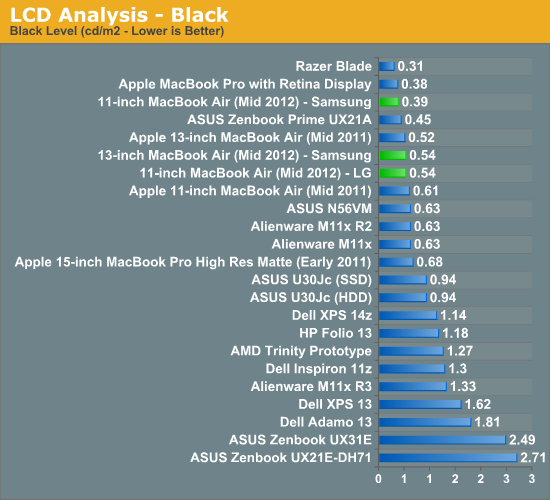
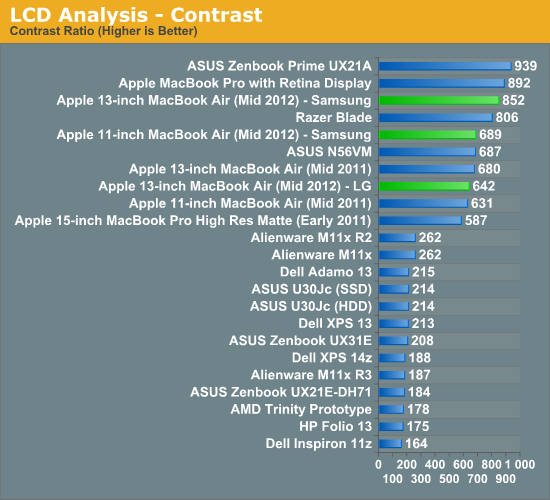
The 13-inch LG panel delivers tangibly worse black levels than the Samsung alternative. There's even a pretty dramatic difference in black levels between even the 11 and 13-inch Samsung panels. It's also possible that there's panel to panel variation at play here that would result in this sort of a difference.
The LG panel is a bit brighter, which helps it reach a decent contrast ratio but the 13-inch Samsung panel's low black levels give it an advantage. Interestingly enough, the 13-inch LG sample performed very similarly to the 11-inch Samsung. I really do wonder how much of this difference is just normal variance between panels.
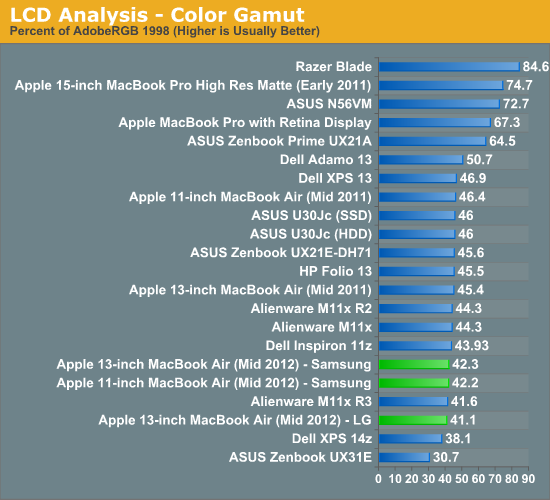
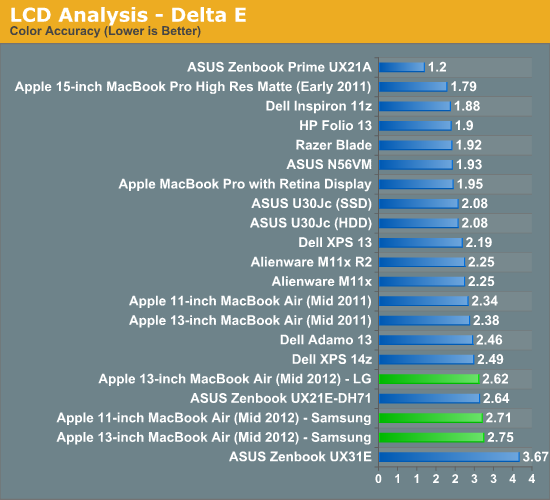
Color accuracy is slightly better on the LG panel, although it's not beyond the noticeable threshold. Color gamut is comparable between the displays.
Independently, neither the Samsung or LG panels is particularly bad to look at. These are still TN panels so you get poor vertical viewing angles, but the quality is still better than the cheaper TNs we often see used in less expensive notebooks. It's when you compare the two or you're used to one that you can really tell a difference: the Samsung panel, particularly when displaying black text on a white background, looks better than the LG.
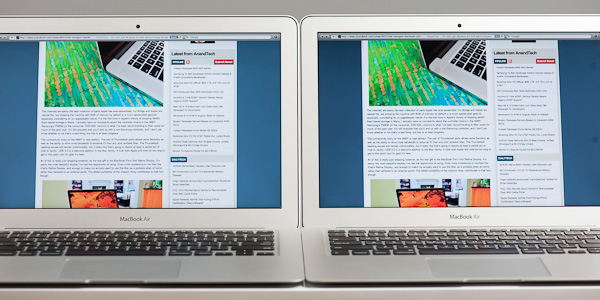
13-inch LG LP133WP1-TJA3 panel (left) vs. Samsung LTH133BT01A03 panel (right)
I had some friends over and tossed them a pair of 13-inch MBAs. One had the LG panel and one had the Samsung panel. They used the MBAs and swapped after a short while. Almost instantaneously they could tell the difference between the panels. Everyone significantly favored the Samsung.
I was actually a bit surprised how quickly they noticed the difference. With these type of things I always assume I'm just more sensitive than most, but in this case the difference was noticeable enough to pick out. Everyone added (and I agreed) that the difference was most pronounced because they were able to switch between two. In a vacuum each one seemed fine.
I tried my best to capture the difference between the two panels on camera. The easiest way to describe the difference is text on the Samsung panel just looks darker (mouse over the panel name in the table below):
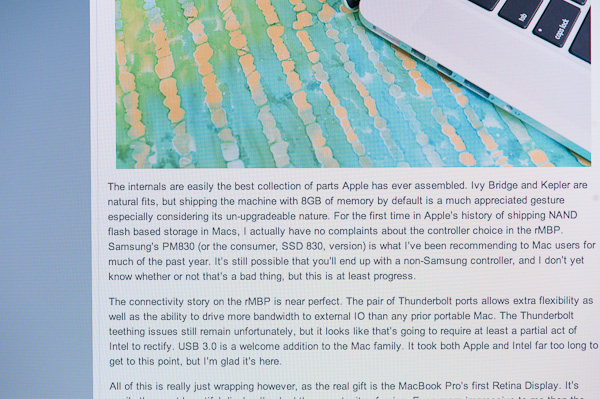
| LG LP133WP1-TJA3 | Samsung LTH133BT01A03 |
| original | original |
Just like last time, I believe the two panels behave differently in how they react to off-center viewing angles but I couldn't really capture the slight differences on camera. Although I didn't have an AUO equipped MBA on hand, the one I saw in an Apple store looked closer to the LG than the Samsung.
The good news is after a calibration pass using Color Eyes Display Pro, the difference between the two is significantly reduced - to the point where I can no longer tell the two apart:
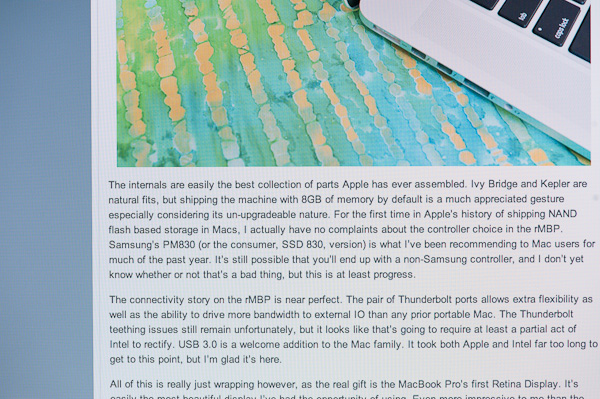
| LG LP133WP1-TJA3 | Samsung LTH133BT01A03 |
| original | original |
The obvious problem with this solution is you need access to a decent colorimeter or spectrophotometer and calibration software. There are some color profiles floating around the web that may help (I've uploaded mine for the LG here, Samsung here) but every panel is going to be at least somewhat different so this is still not perfect.
Subjectively, I'm fine with the LG panel, although I do like the look of the Samsung better. Both are a bit of a disappointment compared to what you get from the Retina Display in the MacBook Pro however. It's just presently what you give up for portability and cost.
To Make a Retina
The thing about the MacBook Air is that it's already quite minimized on the inside. The vast majority of the chassis is occupied by a battery, and there's no traditional HDD or optical drive to remove for additional space. Apple can't simply toss a much higher resolution panel on the system and call it a day, at least not without a tangible reduction in battery life.

13-inch MacBook Air (Mid 2012) - iFixit
Apple had to give the MacBook Pro with Retina Display a 95Wh battery (up from 77.5Wh) just to deliver similar battery life to the regular MacBook Pro. The higher resolution display requires a brighter backlight to push light through the panel and maintain comparable brightness levels.
The motherboard itself can stand to lose a single chip (the PCH) with the transition to Haswell, but that's not going to give us a ton of space either.
In the short term Apple could opt for a slightly thicker chassis (similar to what happened in the 3rd gen iPad) to accommodate a larger battery. Eventually the hope is that panel efficiency will increase to the point where we won't need significantly brighter backlights.


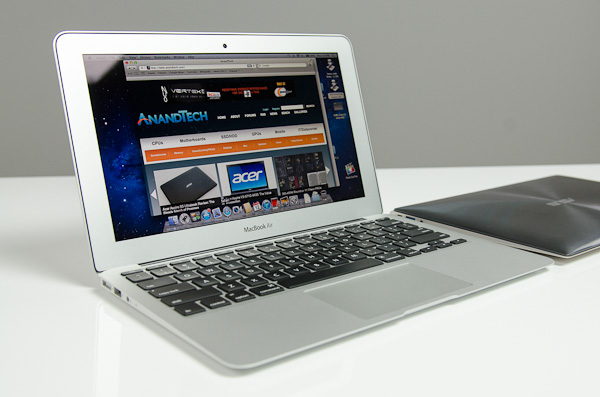








190 Comments
View All Comments
LuckyKnight - Monday, July 16, 2012 - link
I've contemplated a MBA for some time - however I wish they would make a MacBook Pro 13" with dedicated graphics like the ASUS UX32VD.The MBA only has 1 thunderbolt connector, which means there's no cheap way of connecting my existing DVI monitor, HDMI to my TV and gigabit ethernet all at the same time (if that is possible at all).
The MBA also presumably suffers from the 23.967Hz bug as it uses Intel graphics. So it's use as a XBMC client is reduced for me.
I don't want a 15" model any more. This is just too big for me.
The MBA is a very nice product. I would consider the ASUS if they keyboard didn't bend? and it was available in the UK! Despite the faults, still considering it.
If ASUS were to resolve their issues I would probably get that however.
Elwe - Tuesday, July 17, 2012 - link
"The MBA only has 1 thunderbolt connector, which means there's no cheap way of connecting my existing DVI monitor, HDMI to my TV and gigabit ethernet all at the same time (if that is possible at all)."This is true. But you do have a couple of options. One is to use the Apple USB to Ethernet Adapter (http://store.apple.com/us_smb_78313/product/MC704Z... It was made for prior years' models, and it will only 10/100Mb/s. Not anywhere close to ideal, but there it is.
Your other options is to wait and see if something with the ASIX AX88179 chip (or some such) gets released (http://www.asix.com.tw/products.php?op=pItemdetail... I guess USB 3.0 to GigE is not really desired by the market (I guess because most people are either already in a tower and so have other options or are fully OK with wireless).
In this form factor, one has to ask how many high-speed sports are realistic . . . Three? If so, perhaps they have it right (two USB 3.0 and one Thunderbolt given how much people have been screaming for USB 3.0). Or perhaps it should be the other way (I think I would personally rather have the two Thunderbolt and do use either an adapter from Thunderbolt or a USB hub when I need two or more USB ports). Four? Well, I am not sure I know of any Ultrabooks that that this configuration but it would be nice.
reactor - Monday, July 16, 2012 - link
I have a previous gen MBA and tried out the new one in store. Not nearly enough of a leap for me to think about upgrading. Hopefully Haswell comes through with the supposed GPU bump(and maybe, hopefully, a retina display), my old MBA handles everything I need it to do except graphics heavy things and I like the form factor too much to go up to the 15" retina.KPOM - Monday, July 16, 2012 - link
Ivy Bridge is the "tick" part of the tick-tock cycle. It is a small upgrade to the CPU, though the GPU is a bit more of an improvement. Consider that in 2011, Apple switched to the Sandy Bridge from the 5 year-old Core 2 processor. I don't think the 2012 is aimed at 2011 owners as much as it is 2010 and earlier owners, as well as those new to the platform.mastertoller - Monday, July 16, 2012 - link
well with the 2x faster SSD, 8gb ram option, it makes up for it.ltcommanderdata - Monday, July 16, 2012 - link
Great review. How's OpenCL performance like on the HD4000 since that was a sore point with Sandy Bridge that Ivy Bridge corrects? A comparison between the HD4000, 320M and an older discrete GPU like a 330M GT or 6490M would be informative.You've consistently noted in your reviews that Apple's desires for smaller enclosures, GPGPU, and smaller displays are constrained by GPU hardware, particularly from Intel. With Mountain Lion's upcoming release, I wonder if you'll consider examining the software side of things to see how much effort has been put into the GPU drivers and whether they are now up to par with Windows GPU drivers? Once they are released, perhaps a comparison between 10.7.5, 10.8, and Windows 7 with the best recent GPUs from each vendor (Intel HD4000, nVidia GT 650M, AMD 6970M) and one example of an older GPU that still supports OpenCL (nVidia 8xxx/9xxx or ATI HD4xxx) to see if all Macs are seeing development effort or only recent ones. Ideally the benchmarks would not only be games (Portal 2, SC2, Civ V, and a non-Source Engine shooter or two like Deus Ex Human Revolution or Bioshock 2), but also OpenGL accelerated applications (such as Cinebench and Photoshop) and OpenCL accelerated applications (the new OpenCL Photoshop CS5 filters).
De_Com - Monday, July 16, 2012 - link
As a long time reader of AT, I must say how nauseating it has become to read any Apple reviews nowadays, especially Anand's.I believe all objectivity has gone out the window, and that someone else should be given a crack at reviewing Apple products. Both Brian and Dustin have done some cracking reviews lately and I'd like one of these guys to be given a shot at reviewing the next Apple laptop.
Reading the words "awesome", "amazing","infatuated", "it just works"...etc, the reviews have morphed into what seems like some weird sales pitch, seriously am I the only one to notice this?
You'd be hard pressed telling this review apart from the sales blurb direct from the Apple website.
Whenever there's a bad word to be said, like f/f camera, wifi, there are immediate excuses made overlooking them. The camera is crap, unless you've excellent lighting, again glossed over with "well the software is easy and starts quickly". I could go on.
Don't wanna overgripe the situation, most reviews are excellent and well informed, but Anand's Apple reviews have just got so lopsided lately that they have become hard to stomach.
Please try and bring back the objectivity, it's what brought me here in the first place.
KPOM - Monday, July 16, 2012 - link
"As the MacBook Air retains its TN display, for the first time we can actually say that ASUS' Ultrabook offers better viewing angles than the Air. The difference is quite noticeable: ...There's no denying that what ASUS has done is better,"
Yeah, Anand NEVER acknowledges when other products are better than Apple.
De_Com - Monday, July 16, 2012 - link
"The MacBook Air is no longer competing against poorly designed netbooks, but a bunch of clones that are quickly approaching parity across the board. The MBA panel isn't bad, but it needs to be better.Even without a new display however, the MacBook Air continues to be one of the best executed ultraportables on the market today"
Your missing the point, being objective is taking similar products, stepping back and reviewing both in an unbiased way. Never did I accuse Anand of not acknowledging other good products, however I did accuse him of making a bad point followed by glossing over it with a good one, and you sir have made my point for me.
KPOM - Monday, July 16, 2012 - link
On the whole, it IS still one of the best executed ultraportables on the market today. I have seen other ultraportables, and the only ones that I have seen that come close or exceed the Air are the Samsung 9 series and the ASUS Zenbook. They are also priced similarly.Anand's review of the 2011 was far more glowing. This was an evolutionary update, and so the difference isn't as stark, and the display is starting to become more ordinary. However, the rest of the machine is still very good.
Being objective sometimes means praising a product.